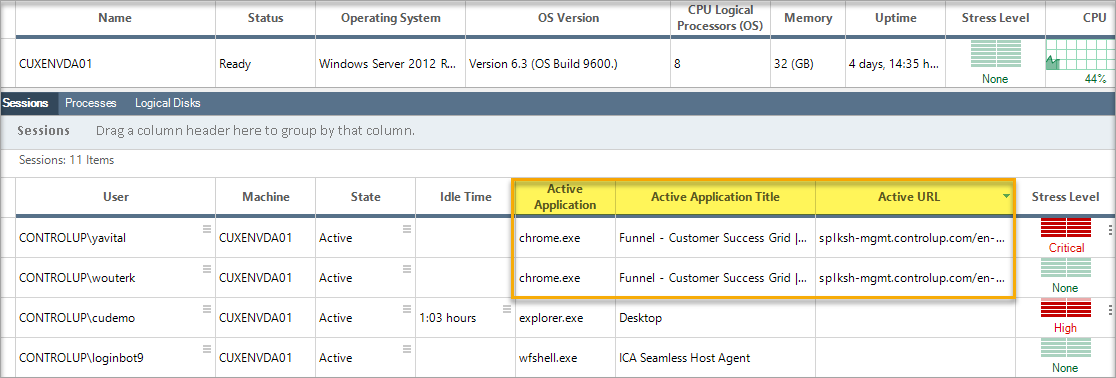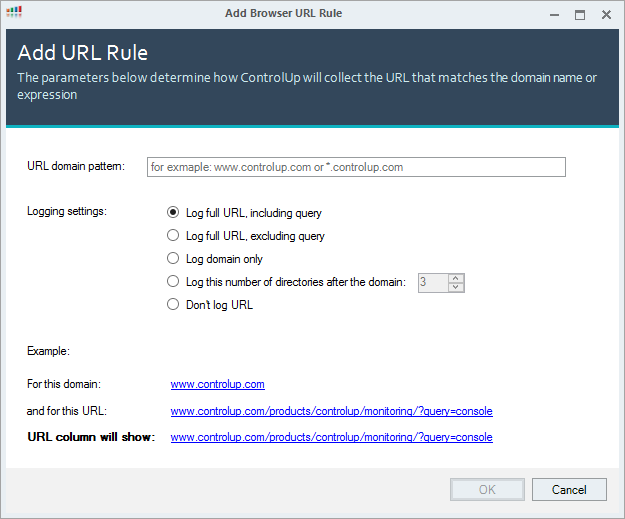- Print
- DarkLight
- PDF
Active Application
- Print
- DarkLight
- PDF
With the Active Application feature which is available in both, Hybrid-Cloud & On-premises environments, you can show real-time information about the title of the application that the user is working with or the active URL in browsers like Chrome, Firefox, IE, and Edge.
Under the Sessions tab, you can see the relevant columns for the Active Application feature:
- Active Application - The name of the application that is currently running in the foreground.
- Active Window Title - The window title of the application currently running in the foreground.
- Active URL - The URL of the foreground browser tab.

Enable settings and set rules for Active Application
The Real-Time Console includes a dedicated settings tab for Active Application.
To enable the feature, select Settings > Active Application > Show Active Application Title checkbox.

In the Active Application tab, you can set different rules for what to display and ignore in the dedicated Sessions column. For example, you can select not to display the full title of the active window.
Rule Guidelines
Application titles containing the words you enter if you click Add Rule and enter a word in the Keywords field are not displayed in the "Active Application Title" column.
- The Keywords field supports wild cards:
- Excel - ignores only the exact match.
- *Excel *- ignores any window title containing this word.
- *Excel - ignores any window title ending with "Excel".
- Excel* - ignores any window title beginning with "Excel".
- Rules are not case sensitive.
- Rules are not applied to browsers' names.

Example:
An organization doesn’t want Excel sheets including the word ‘paycheck’ to display in ControlUp since those are confidential documents.
- In Settings > Active Application > click Add Rule.
- In the Add Active Application Title Rule dialog box, enter the following to the Keywords field: *paycheck *.
- Click OK and the word paycheck is listed in the column with other keywords and the action applied is Ignore.
Once the user openes an Excel sheet with the file name "Paycheck.xlsx", the Active Application Title in the Real-Time Console is shown as [Hidden by rule], as shown below.

Enable settings and set rules for browser URLs
The Real-Time Console now includes a dedicated settings tab for Browser URL.

To enable displaying the Active URL column in the Sessions view and set rules for the feature:
Select Settings > Browser URLs > select Monitor URLs for browser processes checkbox.
Select the number of seconds for a URL to remain unchanged for that URL to be logged and to appear in the Sessions view. The default number is 3.
To set rules for the feature, click Add Rule and the Add URL Rule dialog opens.

Enter a URL domain pattern and select the way you want to view URLs in the Logging settings area.
Click OK and repeat for each URL domain. Your rules appear in the Browser URL Settings under these columns: For URLs matching this domain pattern, This part of the URL is logged.
Security policy delegation
ControlUp admins can now delegate permissions on who can edit Active Applications & Browser URL settings with two new policies added to the Security Policy Pane:

Process footprint & network impact
The ControlUp cuAgentHelper process enables this feature. It is a lightweight component that consumes few resources, detailed here:
- CPU Usage - 0% on average.
- RAM Usage - Up to 5MB memory utilization per user session.
- Network Usage - 0 usage. It uses localhost UDP for communication with the agent.
Enabling this feature does not require restarting the agent endpoints. When enabled on the Real-Time Console, the ControlUp Agent already running on the endpoints activates this feature on-the-fly.

In cases where a user session is in the Disconnected state, the columns are blank, as displayed here:

When a session goes into the Disconnected state, the cuAgentHelper process turns off for that session until Active again, and then the cuAgentHelper process automatically reopens.
In cases of Published Applications, when the user interacts with the application, ControlUp shows the correct information:

When the published application is not in use and the user does not interact within the published application realm, the console shows 'ICA Seamless Host Agent', but the application name is visible under XD Apps In Use.

When no applications are running on the desktop, the columns are shown as follows:




